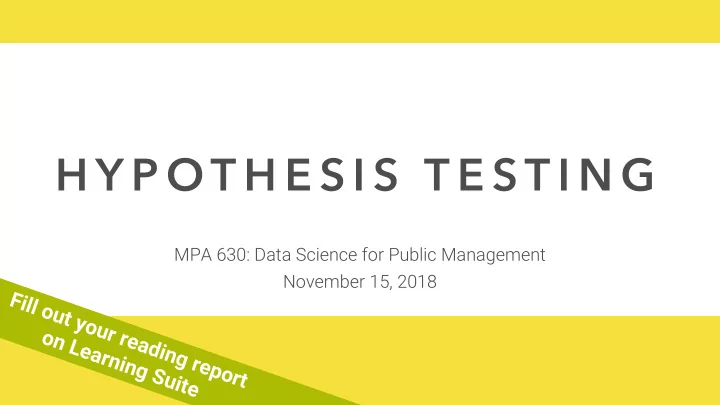

H Y P OT H E S I S T E S T I N G MPA 630: Data Science for Public Management November 15, 2018 Fill out your reading report on Learning Suite
P L A N F O R T O D A Y Randomness, repetition, and replicability Why are we even doing this? (again!) Burdens of proof How to test any hypothesis
R A N D O M N E S S , R E P E T I T I O N , & R E P L I C A B I L I T Y
P O W E R P O S I N G Increases individual Increases testosterone perception of power and decreases cortisol She made a guess at a population parameter and published it This is the process of science!
R U H R O H
B U T W A I T Increases individual Increases testosterone perception of power and decreases cortisol
M O R A L O F T H E S T O R Y Randomness is weird Capturing true population parameters is hard Replication and repetition are needed to check the net
W H Y A R E W E E V E N D O I N G T H I S ? Round 2!
P O P U L A T I O N P A R A M E T E R S Key assumption in the flavor of statistics we’re doing: There are true, fixed population parameters out in the world
̂ ̅ ̂ ̅ P O P U L A T I O N V S . S A M P L E Proportion ! ! , " * Mean Difference between ! # − ! % ! # − ̂ ! % proportions Difference between " # − " % * # − ̅ * % means + Intercept & ' & '
̅ ̂ W H Y W E S I M U L A T E Is it accurate? Is it substantive? Is it real? " $ − " & or ̂ ( $ − ( & real? " an accurate Is ̅ Is ̅ guess of # ? Does it matter? Width of confidence interval Important numbers included in confidence interval
B U R D E N S O F P R O O F
A M E R I C A N L E G A L S Y S T E M Accused must be judged Presumption of innocence Accuser has burden of proving guilt Judge/jury decide guilt based on amount of evidence We never prove innocence; we try (and fail) to reject innocence
L E G A L E V I D E N T I A R Y S T A N D A R D S Preponderance of evidence Clear and convincing evidence Beyond reasonable doubt Why do we have these different levels? We’re afraid of locking up an innocent person
Actual truth Guilty Not guilty Yay! Oh no! Guilty Jury decision True positive False positive (I) Not guilty Oh no! Yay! False negative (II) True negative
S T A T I S T I C A L “ L E G A L” S Y S T E M Sample statistic (δ) must be judged Presumption of no effect (null) You have burden of proving effect You decide “guiltiness” of effect based on amount of evidence We never prove that the null is true; we try (and fail) to reject the null
Actual truth Yes effect No effect ! Result of hypothesis test Yes effect Yay! Oh no! 0.10 0.05 True positive False positive (I) 0.01 No effect Oh no! Yay! False negative (II) True negative
S T A T I S T I C A L S I G N I F I C A N C E There’s enough evidence to safely reject the null hypothesis
P - V A L U E S The probability of observing an effect at least that large when no effect exists
N O B O D Y U N D E R S T A N D S T H E S E http://fivethirtyeight.com/pvalue
H O W TO T E S T A N Y H Y P OT H E S I S
S I M U L A T I O N S A N D H Y P O T H E S E S
Find δ The sample statistic: diff in means, mean, diff in props, etc. Invent world where δ is null Simulate what the world would look like if there was no effect. Look at δ in the null world Is it big and extraordinary, or is it a normal thing? Calculate probability that δ could exist in the null world This is your p-value! Decide!
Recommend
More recommend